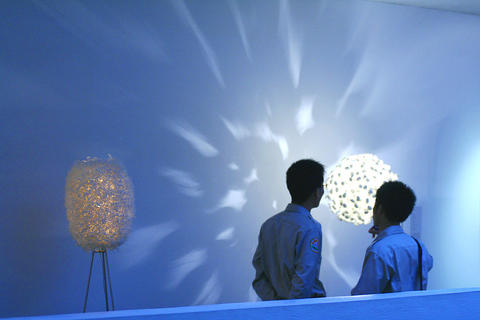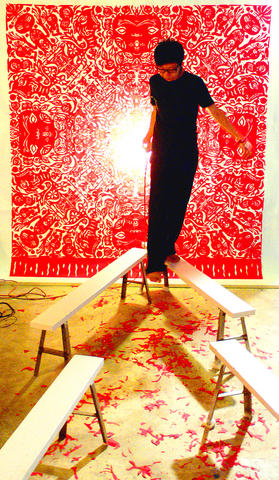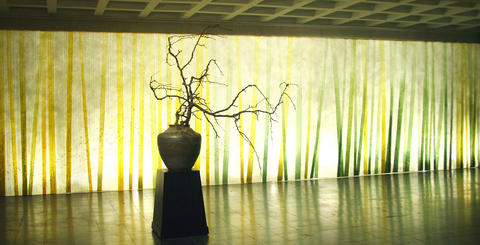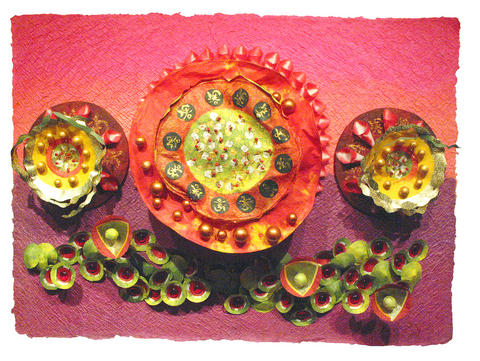Five decades after Chen Su-ho (陳樹火) founded one of the first factories specializing in handmade paper in Puli (埔里), Nantou County, his daughter has returned with an exhibition that gives the traditional craft a modern twist.
When Rita LiChen (陳瑞惠) was growing up, Puli was home to roughly 60 factories where paper was made by hand. Now only six remain. Watching the factories disappear - many moved to China - inspired her father to open a museum to preserve the memory of this chapter in Taiwan's cultural history.
LiChen's father died in a plane crash in 1990, but his dream lives on in the Suho Memorial Paper Museum (樹火紀念紙博物館) in Taipei. The museum is currently hosting its largest collaboration to date at the National Taiwan Craft Research Institute (國立台灣工藝研究所) in Nantou's Caotun Township (草屯). Zhi-Dao: Environment, Tranquility, Reverence (紙道:境,靜,敬) runs through April 27 and showcases the work of nine Taiwanese and international artists chosen by LiChen, who heads the Suho museum.

PHOTO: COURTESY OF TA YANG
"With this show, I wanted to destroy the entire concept of what 'paper' is," LiChen says. "Only by destroying this concept can artists find new ways to express themselves."
"Some people might think our work is too high-brow or think they can't understand it," she adds. "But I don't worry about that. If it's good, they'll naturally come to appreciate it."
Instead of selecting works by the best paper-makers and craftsmen in the field, Zhi-Dao presents a broad group of pieces ranging from paper-based lampshades and jewelry to contemporary art installations like Zeng Pei-ling's (曾沛玲) Tibetan Bhuddism-influenced wall hangings.

PHOTO: COURTESY OF TA YANG
Out of all the artists whose work is on display, Li Chao-cang (李朝倉) seems most set on pushing the boundaries of what "paper" is. Li has wrapped the entrance of the hall in a stretched white polyester tunnel that viewers have to duck through to access his main piece, a crude assemblage of reeds and other materials gathered from Nantou's flora and tied together to resemble the bamboo scaffolding commonly seen at construction sites.
Japanese artist Kobayashi Junko's Bamboo Forest, a giant 50m-by-3m sheet of paper that required the strength of 15 workers to lift and install, encircles the hall's second floor and dominates the exhibit. The paper's dyed vertical stripes gradually shift in hue as the viewer follows the piece around the room, suggesting the changing seasons. Delicate white paper slippers by Zhou Meng-ye (周孟曄) lie scattered in front of the piece. With a reflective score written for the show by Belgian composer Pierre Hujoel, the space exudes an air of serenity that makes viewers want to slip off their shoes and forget the winter cold and bustle of the holiday season.
A visit to the hall's fourth floor - not a part of the Zhi-Dao exhibit - gives visitors an idea of how irreverent LiChen's transformation of the conservative, craft-oriented institute was. Stone teapots carefully hewn to look like old wood, intricately carved bamboo frogs, wicker insects and lacquerware are displayed in glass cases, often with price tags next to them. Not quite the stuff of a modern art gallery.

PHOTO: COURTESY OF TA YANG
Plans for the exhibit met with opposition from staff at the cultural hall, though not from its director. Since the show runs through the Lunar New Year - a time to celebrate beginnings - some said Li's white tunnel wasn't appropriate because the color is traditionally associated with funerals and death. Three large white banners that were to be hung outside the hall advertising the show had to be redesigned, but Li's tunnel stayed.
LiChen has spent 13 years running the Suho Museum, which opened in 1995 after years of planning by her and her siblings. The museum is part of the Suho Memorial Paper Culture Foundation (樹火紀念紙文化基金會), founded after they lost both their parents in a plane crash. Eighteen years after the tragedy, Zhi-Dao is not only a remembrance of things past, but also a challenge to move forward.

PHOTO: BLAKE CARTER, TAIPEI TIMES

April 28 to May 4 During the Japanese colonial era, a city’s “first” high school typically served Japanese students, while Taiwanese attended the “second” high school. Only in Taichung was this reversed. That’s because when Taichung First High School opened its doors on May 1, 1915 to serve Taiwanese students who were previously barred from secondary education, it was the only high school in town. Former principal Hideo Azukisawa threatened to quit when the government in 1922 attempted to transfer the “first” designation to a new local high school for Japanese students, leading to this unusual situation. Prior to the Taichung First

The Ministry of Education last month proposed a nationwide ban on mobile devices in schools, aiming to curb concerns over student phone addiction. Under the revised regulation, which will take effect in August, teachers and schools will be required to collect mobile devices — including phones, laptops and wearables devices — for safekeeping during school hours, unless they are being used for educational purposes. For Chang Fong-ching (張鳳琴), the ban will have a positive impact. “It’s a good move,” says the professor in the department of

On April 17, Chinese Nationalist Party (KMT) Chairman Eric Chu (朱立倫) launched a bold campaign to revive and revitalize the KMT base by calling for an impromptu rally at the Taipei prosecutor’s offices to protest recent arrests of KMT recall campaigners over allegations of forgery and fraud involving signatures of dead voters. The protest had no time to apply for permits and was illegal, but that played into the sense of opposition grievance at alleged weaponization of the judiciary by the Democratic Progressive Party (DPP) to “annihilate” the opposition parties. Blamed for faltering recall campaigns and faced with a KMT chair

Article 2 of the Additional Articles of the Constitution of the Republic of China (中華民國憲法增修條文) stipulates that upon a vote of no confidence in the premier, the president can dissolve the legislature within 10 days. If the legislature is dissolved, a new legislative election must be held within 60 days, and the legislators’ terms will then be reckoned from that election. Two weeks ago Taipei Mayor Chiang Wan-an (蔣萬安) of the Chinese Nationalist Party (KMT) proposed that the legislature hold a vote of no confidence in the premier and dare the president to dissolve the legislature. The legislature is currently controlled